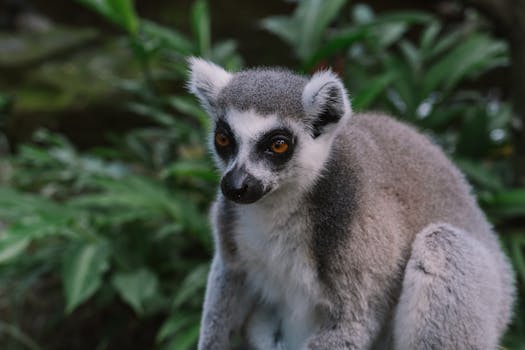Madagascar Uncovered: Wildlife and Forests Beyond the Beaches
Madagascar, an island nation nestled in the Indian Ocean, is often celebrated for its pristine beaches. However, this perception barely scratches the surface of what this unique destination has to offer. Beyond the sandy shores and crystal-clear waters, Madagascar is a treasure trove of biodiversity, teeming with unique wildlife and lush forests that are ripe for exploration.

This verdant heart of Madagascar, pulsating with vibrant fauna and flora, offers an unparalleled adventure that transcends the typical beach holiday experience.
The island's unique geographical isolation has fostered an environment where evolution has taken a distinctive path. As a result, Madagascar boasts a rich tapestry of wildlife that is unlike any other on the planet. The most iconic of these creatures are undoubtedly the lemurs. These elusive primates, found nowhere else in the world, have become synonymous with Madagascar's wildlife. With over 100 species varying dramatically in size and appearance, lemurs offer a fascinating glimpse into the island's evolutionary history.
However, lemurs are just one aspect of Madagascar's diverse fauna. The island is also home to a myriad of other unique species including chameleons, frogs, birds and insects, many of which are endemic to Madagascar. This array of wildlife provides endless opportunities for nature enthusiasts and adventure seekers alike to immerse themselves in an extraordinary natural world.
Complementing this vibrant fauna is Madagascar's lush vegetation. The island's forests range from dense rainforests to dry deciduous forests and spiny deserts. Each of these ecosystems supports a unique community of plant life, including several species of baobab trees that tower majestically over the landscape. These ancient trees are another symbol of Madagascar's unique biodiversity.
Exploring these forests is an adventure in itself. Whether it's trekking through the dense undergrowth in search of elusive wildlife or marveling at the towering baobabs against a sunset backdrop, each experience offers its own unique thrill. Furthermore, these forests play a crucial role in supporting the local communities, providing resources such as timber and medicinal plants.
However, Madagascar's wildlife and forests face significant threats. Deforestation, driven by slash-and-burn agriculture, illegal logging, and mining, is causing habitat loss at an alarming rate. This, coupled with hunting and the illegal pet trade, poses a serious threat to the island's unique biodiversity. Conservation efforts are therefore crucial in preserving Madagascar's natural heritage for future generations.
Madagascar's wildlife and forests offer an experience that goes beyond the typical beach holiday. It's an adventure that immerses you in a world of unique biodiversity, where every creature and plant tells a story of evolution unlike any other. However, this natural treasure trove is under threat and needs our collective efforts to ensure its preservation.
The journey into Madagascar's verdant heart is not just about witnessing its unique biodiversity. It's also about understanding the intricate balance between humans and nature, and the need for sustainable practices to preserve this delicate equilibrium. As we explore Madagascar's wildlife and forests, we are not just spectators but active participants in a global effort to conserve our planet's biodiversity.
So next time you think of Madagascar, look beyond its beaches. Venture into its verdant heart and vibrant fauna. Experience the thrill of discovering its unique wildlife and lush forests. And most importantly, join in the effort to preserve this unparalleled natural heritage. Because Madagascar is more than just a beach destination - it's a testament to the wonders of nature and evolution, a world waiting to be explored.
How to Get There
Reaching Madagascar often begins with a flight to Ivato International Airport, situated near the capital, Antananarivo. Several international airlines provide routes from Europe, Asia, and parts of Africa. For those travelling from the United States or other regions, connecting flights through major hubs such as Paris or Johannesburg are common. Upon arrival in Antananarivo, domestic flights, rental cars, and chartered buses are available to explore the vastness of the island.
Key Places to Visit
Madagascar, a mosaic of unique landscapes and ecological wonders, unveils its treasures through several key destinations:
- Ranomafana National Park: Known for its lush rainforest and hot springs; it's a prime spot for catching sight of numerous lemur species.
- Avenue of the Baobabs: The iconic baobab trees lining the dirt road present a breathtaking natural avenue that becomes magical at sunset.
- Isalo National Park: Offering a dramatic terrain of sandstone formations, this park invites hiking enthusiasts to explore its deep canyons and natural pools.
- Tsingy de Bemaraha: A UNESCO World Heritage Site featuring a labyrinth of sharp limestone pinnacles alongside lush forests and mangrove swamps.
- Ifaty: Located along the southwest coast, Ifaty is famous for its beaches, snorkeling, and the nearby spiny forests rich in unique wildlife.
Visit these websites for more info!
Below are some useful websites travelers:
- travelmadagascar.org - An insightful resource for detailed travel itineraries and conservation-focused touring options in Madagascar.
- wildmadagascar.org - Offers an extensive overview of Madagascar’s wildlife and environmental issues, ideal for eco-friendly travel planning.
- madagascar-tourisme.com - The official site for Madagascar tourism; it provides practical travel tips, regional highlights, and cultural insights.
- lemurs.duke.edu - Managed by Duke Lemur Center, this site offers comprehensive information on lemur conservation efforts and how tourists can contribute responsibly.